COMP0034 2022/23 Coursework 1 specification
Hello, dear friend, you can consult us at any time if you have any questions, add WeChat: daixieit
COMP0034 2022/23 Coursework 1
specification
Last updated: 05/0 1/23 at 12 :57
Contents
![]() Technologies that must be used
Technologies that must be used
This document specifies coursework 1 which is worth 50% of the assessment marks available for the module .
Design , create and test a web dashboard application in a way that addresses the aspects detailed in each section:
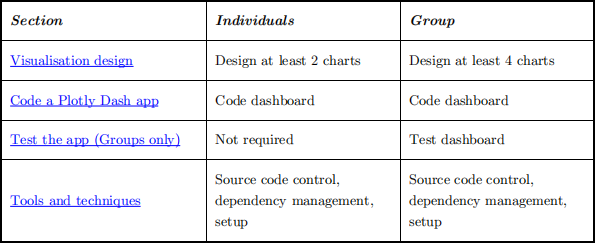
Data
You must only use the data sets as approved for COMP0035 .
Which data set to use depends on your circumstances . Please refer to the table below .
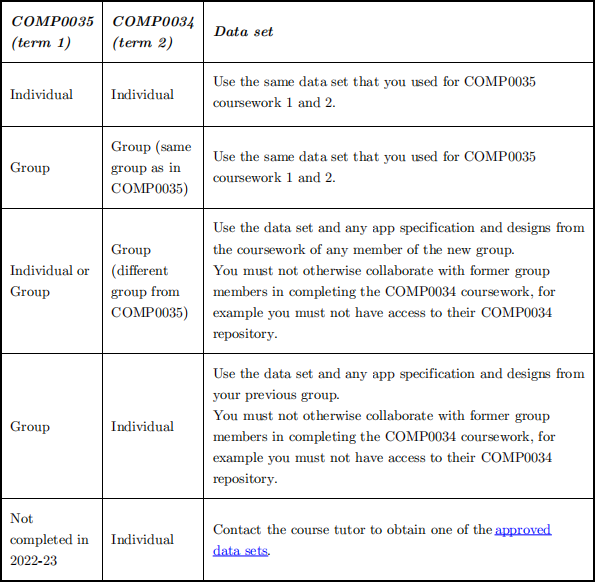
The same rules for ethics and data protection apply as for all other coursework in COMP0034 and COMP0035.
Getting started
1. Create a GitHub repository using the classroom. All aspects of the coursework must be included in a single source code controlled repository. This should be in GitHub unless you have a reason that requires you to use an alternative. Use the relevant link to create a copy of the starter repository.
Individuals
GitHub classroom link for individuals
1. Login to GitHub.com.
2. Click on the GitHub classroom link.
3. Accept the assignment.
4. If prompted, accept to join the comp0035-ucl organisation.
Groups
GitHub classroom link for groups
1. Login to GitHub.com.
2. Click on the GitHub classroom link.
3. One person only (first person from the group)
1. Accept the assignment.
2. If prompted, accept to join the comp0035-ucl organisation.
3. Create the group (team) using the same name as your Moodle group name (e.g. Group1, Group2 etc.).
4. All other group members
1. Accept the assignment.
2. If prompted, accept to join the comp0035-ucl organisation.
3. Select your group (team) name from the list.
2. Add a copy of the following to your repository:
prepared data set (COMP0035 CW1)
persona(s) (COMP0035 CW2)
questions to be answered (COMP0035 CW1)
Optionally add any other files you need to use e.g. requirements/user stories, wireframes.
You are not marked against how well you meet the designs from COMP0034, however they should help you so it is recommended that you use them.

Add the explanation text to README.md using markdown with an appropriate heading such as # Visualisation Design
Explain and evaluate the design of your dashboard and the visualisations it contains with reference to appropriate literature.
1. State the target audience1 and the question(s)2 that the visualisation(s) is/are intended to address.
2. Explain the design for the dashboard and each visualisation. The designs should be appropriate for the target audience and the question(s) the visualisation is designed to address. Give reasons for your choices. Use appropriate literature/references to support your decisions.
3. Evaluate the final dashboard and visualisations with respect to the design and intended audience and purpose.
The ‘design’ refers to the visual design and not the python (or other) code. Aspects to consider include but are not limited to:
the type of chart (e.g. pie, bar etc) and its appropriateness for the question/audience.
visual aspects of the design (e.g. style, colours, titles, etc) and their appropriateness for the question/audience.
1 Use the persona from COMP0034 CW1. You may change this if needed. The persona itself is not considered in the marking, however the target audience must be described in sufficient detail to allow the marker to assess whether your design is appropriate for the audience.
2 State the question, or questions if appropriate, from COMP0034 CW1. You may change the questions if needed.
Key points to note:
Make sure you understand the academic terms ‘state’, ‘explain’ and ‘evaluate’ . There is no word limit for the explanation text since the number of visualisations can
vary. As a guide, around 200-300 words per visualisation.
Use relevant literature to support your design choice. Refer to the course reading list and/or carry out your own research.
Discuss the overall dashboard design if relevant. For example, a dashboard that has
interactive elements (e.g. selectors/menu options) and structure (e.g. charts that are optionally visible/hidden) that are within the dashboard but not specific to a particular visualisation; then it would be relevant to explain these also.
![]() There are no marks for interpreting what the data in the chart shows. That is, do not try
There are no marks for interpreting what the data in the chart shows. That is, do not try
to explain what the answer is to the questions. Answers such as “the chart shows that x breed is the most common” would be ignored in the marking.
Develop a visualisation dashboard app using the python version of Plotly Dash. The dashboard code should include:
styling i.e. CSS; use of Dash bootstrap components or similar is suggested layout i.e. HTML layout/elements
at least 2 visualisations (charts) for individuals and at least 4 for groups interaction using callbacks
You do not have to write about your app. However, if you wish to provide an explanation of any aspect of your app that you think the markers should be aware of then note this in README.md (add an appropriate heading such as # Dash app) . For example:
![]() to explain decisions that you made with respect to the application design or code
to explain decisions that you made with respect to the application design or code ![]() to indicate features of your app or code that might not be obvious
to indicate features of your app or code that might not be obvious
![]() to indicate aspects of the app that you didn’t manage to get working as you would have
to indicate aspects of the app that you didn’t manage to get working as you would have
desired. For these please state:
![]() what the app should do
what the app should do
![]() what the app current does
what the app current does
![]() what steps you took to try and address the issue
what steps you took to try and address the issue
Test the app (groups only)
1. Create and run Dash app integration tests using Selenium and pytest. Selenium is suggested in the Dash official documentation. Create appropriately named test files and directory.
2. {optional} Create unit tests for any Python helper functions (e.g. using pytest or unittest).
3. Provide the following evidence in README.md (add an appropriate heading such as # Testing):
![]() state the types of tests you created with relative link(s) to the relevant test file(s)
state the types of tests you created with relative link(s) to the relevant test file(s) ![]() provide evidence (e.g. screenshot, saved test reports) of the results of the tests
provide evidence (e.g. screenshot, saved test reports) of the results of the tests
running, coverage reports, CI reports etc
Add the evidence to README.md in an appropriately named section e.g. ‘Tools & Techniques’
1. Provide evidence that demonstrates effective use of appropriate use of software engineering tools and techniques. The type of evidence that is expected is:
![]() Source code control: Add URL to your repository to README.md. Demonstrate use
Source code control: Add URL to your repository to README.md. Demonstrate use
of source code control ( evidenced by commit history). This should be GitHub. If
you can’t use GitHub then a suitable alternative must be agreed with the course tutor.
![]() Set-up instructions: Add instructions to set up and run your app to README.md
Set-up instructions: Add instructions to set up and run your app to README.md ![]() Dependency management: Provide a requirements.txt file in your zip file, or if
Dependency management: Provide a requirements.txt file in your zip file, or if
an alternative then appropriate files and instructions for using these
![]() Anything else (optional): If you use other tools/techniques please provide
Anything else (optional): If you use other tools/techniques please provide
screenshots, PDF, or other formats that can be downloaded and included in your zip (these must be able to be opened using freely available tools). URL links to external sites are not accepted for marking purposes since they may be modified after the Moodle submission timestamp.
Note: Continuous Integration is included in the testing section.
You are encouraged to continue to track your own progress weekly to help you achieve the deadline. There are tasks on Moodle that aim to help with this. However, there are no longer any checks on progress from the course teaching team; nor any marks awarded for evidencing progress tracking.
Use the weekly scheduled lab sessions to work on your coursework. The coursework tutors and several PGTAs will be available in each session and able to give you support and guidance.
Outside the scheduled lab sessions please post any requests for technical support to the Moodle Q&A. Do not send emails to the tutor or PGTAs directly as you won’t receive a response.
When posting questions about your code, please post the URL to your repository. This enables the tutor and PGTAs to see your code which is usually essential for solving technical problems! Other students won’t be able to access your repository from this URL so long as your repository is private and is within the ucl-comp0035 organisation.
Submit your work on Moodle as a single .zip in the assignment submission. Moodle is used as the submission date/time and to authenticate students.
The .zip should expand to the correct folder structure with all required files. GitHub provides an option to download repository contents as a zip. Ensure that all files are included in the zip, files that are only provided as URLs will be excluded from marking consideration (since they
may be modified after the coursework is submitted).
Please refer to Moodle for the deadline date and time.
The submission must include:
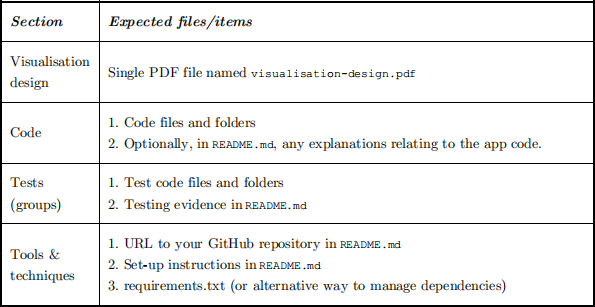
Late submission
Late submission rules apply. Any penalties for late submission are applied by the computer science teaching and learning team when marks are entered in portico. The mark you see in the Moodle gradebook, therefore, is the mark before moderation or any penalty has been applied.
If you have an approved extension resulting from a SoRA or Extenuating Circumstances, these will be carefully checked by the teaching and learning team before marks are entered in portico. However, the due date in Moodle will not be modified, so it may appear on Moodle that your submission is late even though you have an approved extension to cover the period.
Mark allocation and calculation
Marks will be allocated for the coursework as follows.
It is expected each person will spend 20 hours on the coursework. While not exact, an indication of the effort given the marking weighting is shown below.
An overhead for co-ordination is expected for groups. This has been assumed at 1 hour per person per week for 6 weeks ( total 24 hours). This allows for a 30-minute weekly meeting as well as review of work items.

Groups are required to complete an IPAC assessment that includes their own and peers performance. The calculated IPAC rating will then be applied to the raw group mark i.e.
individual 's coursework mark = group mark * IPAC rating.
IPAC guidance is given in theassessment overview .
Grading criteria
The ‘UCL Computer Science: Marking Criteria and Grade Descriptors’ will be used to assess the coursework (using only the criteria that are relevant to this coursework). In addition to the standard descriptors, further guidance is given for this coursework in the table below. Given there can be a wide range of solutions it isn’t possible to cover everything you might do to achieve a given level. The following should be used as guidance. Higher mark bands assume that the criteria from lower bands have been achieved.
Some aspects below relate only to groups, individuals, or both. Check the coursework content section of this specification for what each needs to include.
Visualisation design
As a guide, marking considers aspects such as:
![]() did you meet the requirements of the section?
did you meet the requirements of the section?
![]() the extent to which the design is appropriate for the given audience and purpose
the extent to which the design is appropriate for the given audience and purpose
![]() the extent to which the design considers/is influenced by relevant visualisation design
the extent to which the design considers/is influenced by relevant visualisation design
literature
![]() the quality and nuance evidenced in the explanation and evaluation
the quality and nuance evidenced in the explanation and evaluation
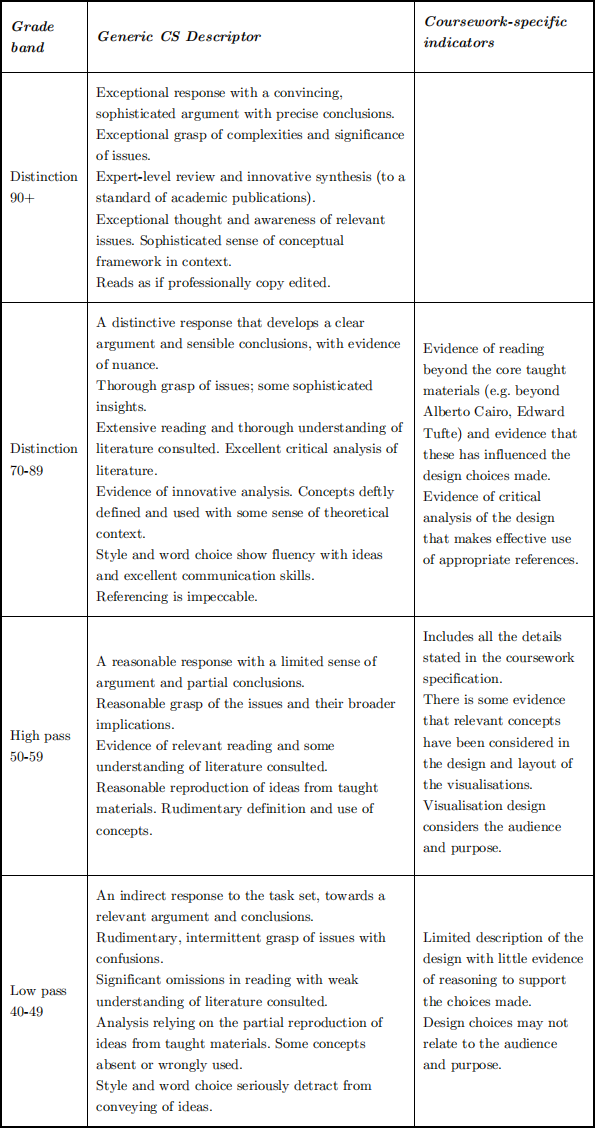
Dash app and code
As a guide, marking considers aspects such as:
![]() did you meet the requirements of the section?
did you meet the requirements of the section?
![]() structure of the app
structure of the app
![]() appropriate use of the required technologies: Dash HTML, CSS (e.g. dash-bootstrap or
appropriate use of the required technologies: Dash HTML, CSS (e.g. dash-bootstrap or
other), Plotly Express/Go, dash callbacks
![]() code quality
code quality
![]() range of skills/sophistication of the solution/complexity of the coding techniques involved
range of skills/sophistication of the solution/complexity of the coding techniques involved
etc. demonstrated in the resulting application

![]() As a guide marking considers aspects such as:
As a guide marking considers aspects such as:
![]() did you meet the requirements of this section?
did you meet the requirements of this section?
![]()
![]() the range challenge and complexity of the test code.
the range challenge and complexity of the test code.
the quality and structure of the test code. This includes code quality , test naming and structure, documentation , appropriate use of assertions, use of fixtures etc.
the extent to which your tests cover your code base. This is not assessed using coverage statistics since a single selenium test can appear to provide 100% coverage. It will be assessed by evidence that your tests test the core functions and features of your dashboard and any of the helper functions you create in your code.
use of supporting tools such as continuous integration to run the tests e.g. using GitHub actions.

Tools and techniques
![]() As a guide marking considers aspects such as:
As a guide marking considers aspects such as:
![]() Has source code control been used regularly and appropriately?
Has source code control been used regularly and appropriately?
![]() Are the dependencies managed using an appropriate technique? Are all the dependencies
Are the dependencies managed using an appropriate technique? Are all the dependencies
included?
![]() Are set up instructions provided? Was the app able to be run after the set-up instructions
Are set up instructions provided? Was the app able to be run after the set-up instructions
were followed?
![]() Is there any evidence beyond the base course content? Basic knowledge expected is use of
Is there any evidence beyond the base course content? Basic knowledge expected is use of
requirements.txt, explanation of setup in README.md, and use of source code control with regular commits and appropriate commit messages).
These are not covered by the generic CS grading criteria.
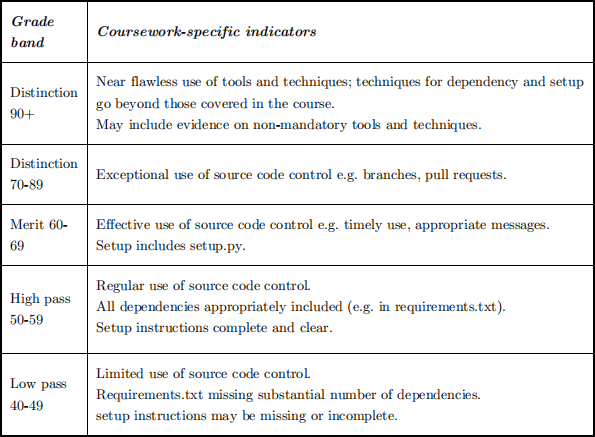
Read the assessment overview referencing guidance .
2023-02-07